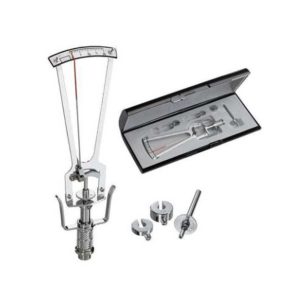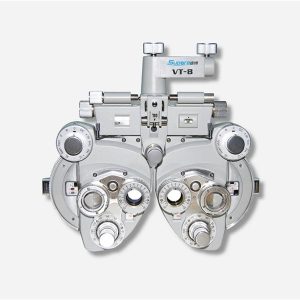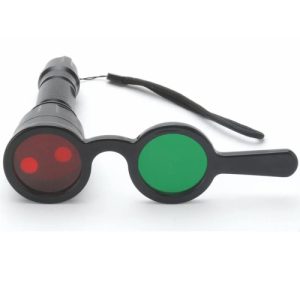-
This product is used to measure the intraocular pressure (IOP) by measuring the depth produced on the surface of the cornea by a load of a known weight. Each division on the scale corresponds to 1/20mm corneal depth. Features: Schiotz type All the parts that contact the cornea are made of stainless steel and are anti-acid, which does no harm to issues The instrument is safe, reliable, accurate, and convenient to carry
Tonometer
-
Features: Equipped with comprehensive measuring functions, it provides SPH, CYL, AXIS and pupil distance optometry Durable and easy to operate Easily and intuitively read the sphere focal scale value High eco-friendly materials Design fitting the face curve and no stimulation Easy to take and clean Free switch between the cross-cylindrical lens and the rotary prism When the rotating risk is turning by the sphere, it can make sphere power adjust 3.00D for big scope. It is designed expediently and smartly for a particular cross cylinder. Supporting supplementary lens could increase scope of measurement. Technical Specifications: Sphere Range:-19.00~+16.75m-1 Step: 0.25m-1, 3.00m-1 Cylinder Range: 0.00~-6.00m-1(Measuring Range With Accessories0.00~-8.00m-1) Step: 0.25m-1 Cylinder Axis Range: 0~180°, Step:5° Distance of Optical center (also known as Pupil) Range: 50~75mmStep: 1mm Sight Switch Range:∞~380mm (distance of Optical center is64mm) Front Chin Test Range: 0~16mm Distance (from cornea vertex to the lens surface) 16mm Standard Accessories Lens two pieces of Auxiliary Cylinder -2.00m-1 and -0.12m-1 respectively Standard Accessories one piece of M2 Hexagon wrench , one piece of a Myopia Standard Card, two piece of Myopia Standard Card , one piece of standard card holder , a dust cover Auxiliary Lens “O”:Open aperture “R”:Retinoscope lens “R”:Retinoscope lens “R”:Retinoscope lens *Lens of +1.50m-1 ,It is suit for the distance of 67 centimeters “P”:Polaroid * it is used for examining the dioptric balance of eyes , Implicit strabismus and stereo vision “RMV”:Red Vertical maddox *Be used to examine Implicit strabismus “RMH”:Red horizontal maddox *Be used to examine Implicit strabismus “WMV”:Plane Vertical Maddox *Be used to examine Implicit strabismus “WMH”:Plane horizontal maddox *Be used to examine Implicit strabismus “RL”:Red lens *Be used to examine eye function, Blending function and Implicit strabismus “GL”:Green lens *Be used to examine eye function, Blending function and Implicit strabismus “+”:Test mark of optical center adjustment “+.12”:Dioptric of the Spherical Lens is +0.12m-1 *Be used for the semi-adjustment of sphere lens, 0.25m-1 “PH”:1mmPinhole lens *Be used to exclude visual non-refractive errors of the tested eye “6ΔU”:6ΔBottom-up prism *Be used to examine the rotating prism with the detection of nearly horizontal squint “10ΔI”:10ΔBottom-up prism *Be used to examine the rotating prism with the detection of nearly horizontal squint “±0.50”:Cross-cylindrical lens *Be used to examine the corrected dioptric of the Presbyopia and spherical lens “OC”:Black lens size 338(L)×99(W)×292(H)mm NW about 5kg
View Tester (Manual Phoropter)
-
The Worth Four Light Test, also known as the Worth’s Four Dot test or W4LT, is a clinical test mainly used for assessing a patient’s degree of binocular vision and binocular single vision. Binocular vision involves an image being projected by each eye simultaneously into an area in space and being fused into a single image. The Worth Four Light Test is also used in detection of suppression of either the right or left eye. Suppression occurs during binocular vision when the brain does not process the information received from either of the eyes. This is a common adaptation to strabismus, amblyopia and aniseikonia.
Worth 4 Dot Test Equipment

Zenrox Healthcare Solutions - Advanced Medical Equipment in Lagos
Zenrox offers cutting-edge medical equipment and comprehensive support services in Lagos. Explore our products designed for superior healthcare delivery. Contact us today for innovative medical solutions.




 No products in the cart.
No products in the cart.